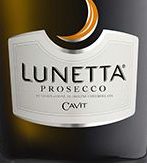Lunetta Prosecco is one of the hottest sparkling wine brands on the American market, and there’s a good reasonta why — it’s well-made, inexpensive and widely available, an excellent wine to celebrate.
It also is lower than many wines in alcohol, about 11.5 percent, so it’s a pleasant companion to take to a party and, unless you over indulge, it won’t give you a headache in the morning.
In the past, sparkling wines weren’t my go-to beverage, and when I did drink them, I would generally lean toward Spanish Cava, which I took a shine to a decade ago when, like Prosecco, it was hard to find in New England markets. That’s not the case any more, and both wines offer very good, affordable alternatives to French Champagnes and higher-end American sparklers.
Initially, I never thought about trying Prosecco, a wine I painted with the same brush as the overly-sweet Lambrusco that I had a glass of once back in the 1970s when Riunite was forcing it onto the American market with a terribly sexy national ad campaign. I’ll admit it. I was foolish to associate them. It was done out of ignorance. The wines are nothing alike, not even the same color. But they do both sparkle, and their names end in “o.”
A few years back, friends started bringing Prosecco to dinner parties, and I tried it without high expectations. I was surprised by its refreshing, semi-dry flavor, but I hung on to my preference for the brut Cava.
Now, there is a wide variety of choices of Prosecco and Cava in Pioneer Valley stores. Many of them, like Lunetta, are dry and excellent values ranging from $10 to $15. There’s a reason why they’re so ubiquitous. Sparkling wines and Prosecco, particularly, are all the rage.
In the last two years, sales of imported sparkling wines have hit their stride in the U.S, and Prosecco is leading the bunch, according to a recent article in the “Shanken News Daily,” an online newsletter that reports on the wine and spirits industry.
In 2015, Prosecco sales in this country topped 4 million cases, and the wine’s growth over the past two years was 1.5 million cases, an increase that nearly matches the total sales of Champagne in the U.S., the article said.
Lunetta, little moon in Italian, is produced by Cavit, a very large Italian corporation that’s known for its popular Pinot Grigio and Pinot Noir, neither of which are high on my favorites list, but chief winemaker Anselmo Martini, one of Italy’s top enologists, also makes some higher quality wines in Cavit’s new, state-of-the-art winery, and Lunetta is one of them.
Lunetta Prosecco is made from 100 percent Glera, a white wine grape formerly known as Prosecco that has been traced back to the Roman Empire when it was grown near the village of Prosecco in northeastern Italy, not too far from Venice.
The Glera grapes used in Lunetta are grown in the Veneto region, the regulated district for producing Prosecco wine. The name of the grape was changed in 2009 to ensure that winemakers growing it in other regions couldn’t call their sparkling wines Prosecco.
For Lunetta, hand-picked grapes are turned into sparkling wine using the Italian Charmat method. With the process, the primary fermentation takes place in temperature-controlled stainless steel tanks. The secondary fermentation is for 30 days, also in stainless steel tanks put under pressure to create the bubbles. Then the wine is promptly bottled and shipped, Martini says in his tasting notes. The method is cheaper and much faster than the Traditional Champagne Method, where the secondary fermentation is done in the bottle.
By using the tanks, the cost of production is not only lower, but the consistency of the wine also can be maintained, advocates say.
I think you get what you pay for when you buy fine Champagne, however, since the French wine is far out of my price range, I’m happy to enjoy Lunetta, a pale-straw colored, dry wine that sparkles with fine bubbles, has the aroma of apple and peach with a crisp, clean taste and a smooth finish.
Lunetta Prosecco may not be Champagne, but it goes on sale for $9.99, and I have a bottle in the refrigerator right along side of one of my favorite Cavas. I plan to enjoy them both with some heavy hors d’oeuvres.
Suggestions of wines in the $10 range are always appreciated. Warren Johnston can be reached at raise.your.glass.to.wine@gmail.com.



